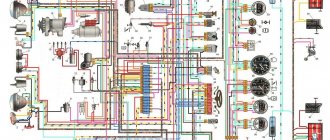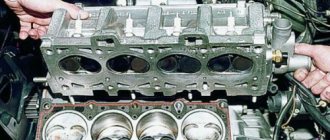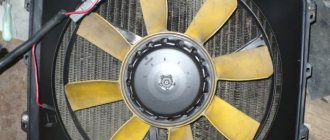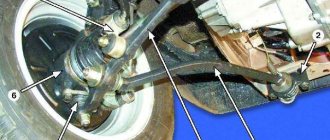Car owners of domestic cars often encounter electrical wiring faults, which can lead not only to the inoperability of certain systems, but also to the impossibility of movement in general. To prevent this, owners of “nines” need to know what the VAZ 2109 electrical circuit is and what symptoms indicate its malfunction.
Signs of trouble
There are several types of vehicle electrical wiring conditions in which VAZ 2109 owners are forced to look for breakdowns:
- The vehicle cannot perform its primary function, that is, it cannot drive. Either the wiring diagram of the VAZ 2109 is damaged, or one of the main components of the car is not working.
- The car can drive, but the systems sometimes start to act up or not work correctly.
If, when trying to start the engine, the driver fails, but fuel flows normally into the injector or carburetor, then most likely the problem lies in the wiring:
- If the car runs on a carburetor, then first of all you need to check the spark plugs and high-voltage wire harness. It would not be superfluous to diagnose the distributor, as well as the ignition coil. It also makes sense to check the engine compartment wiring on carburetors.
- When it comes to the injector, often the main cause of the problem is the electronic engine control system. If the system does not allow processing signals from sensors and subsequently cannot issue commands for additional components or mechanisms, then the problem must be looked for in it.
Wiring on the domestic “nine”
Both in carburetors and injectors, often the cause of electrical equipment malfunction is burnt contacts, in particular in the ignition switch. If the ignition switch or mounting block cannot work fully, at least the interior lights will not work. In addition, if the devices are faulty, other electrical equipment may also fail to operate, for example, washers, fans, glass cleaners, etc.
Summary
We hope that we have covered in sufficient detail the danger that awaits owners of VAZ 2109 cars due to the poor technical condition of the standard wiring. This is especially true for older cars, which often have had more than one owner during their operation. And the best way to protect yourself and preserve your car is to correctly and timely replace the wiring.
Car owners of domestic cars often encounter electrical wiring faults, which can lead not only to the inoperability of certain systems, but also to the impossibility of movement in general. To prevent this, owners of “nines” need to know what the VAZ 2109 electrical circuit is and what symptoms indicate its malfunction.
Carburetor internal combustion engine
Before we talk about breakdowns of carburetors and electrical equipment, we suggest you understand the scheme by which the system works:
- When the driver turns on the ignition, but does not start the engine, power is supplied through the high-voltage wiring harness to the motor terminals, and the indicators on the instrument panel light up.
- Next, the starter activates the crankshaft, as well as the entire piston group. In the same way, the voltage through the high-voltage wiring harness starts the generator. The panel continues to work.
- Then power from the device is supplied to the ignition coil, which begins to generate a pulse. The impulse arrives through the high-voltage wire harness to the distributor, the instrument panel works.
- After this, the crankshaft of the motor begins to rotate the distributor drive. The device begins to close the contacts, thus transmitting the discharge through the same high-voltage wire harness to the carburetor spark plugs. The instrument panel continues to operate normally.
Classic ignition
If you cannot start the engine on a carburetor, you need to pay attention to diagnosing the following elements:
- Inspect the electrical wiring between the coil and the generator. You need to check the contacts for breaks or oxidation, sometimes you can simply clean them, in some cases they require replacement. If the electrical circuit itself is in poor condition, then it may make sense to replace the wires.
- You should also diagnose the ignition coil. First of all, you need to check for the presence of a spark. To do this, remove the high-voltage wire from the distributor harness and bring it to the metal elements of the engine compartment. When you try to start the engine by turning the ignition key, a spark should appear from the high-voltage wire. If it is not there, then the coil is faulty and needs to be repaired or replaced.
- In addition, you need to check the distributor chain and the spark plugs themselves. If you see that the high-voltage wires in the harness are in a sad state, then it may make sense to change them. Carry out diagnostics of the internal slider, as well as the carburetor spark plugs themselves (video author - MR. Boroda).
Electronic ignition
The VAZ 2109 can be equipped with an electronic, that is, contactless switch, which is mounted between the coil itself and the distributor. The electronic system is designed to provide a better spark if the engine operates on a lean fuel mixture. If the pulse is too low or completely absent, as you were able to verify when checking for the presence of a spark, then it would be better to change the switch. If the installation of a new device does not solve the problem, it will be necessary to completely or partially change the electrical wiring. There is a possibility that the resistance level in the circuit is very high, and this contributes to a too weak spark.
Removing the low panel
Dismantling a low panel may be required not only to replace it, but also to perform repairs of varying degrees of complexity. The VAZ 2109 wiring diagram for the injector will be our main assistant. In addition to this, we will need a standard set of tools
.
Tip: For convenience, remove the steering wheel, and the instrument panel becomes accessible for removal.
The work algorithm will be approximately as follows:
- first of all, the handles that control the interior heater and the operating modes of the electric motor of the heating system will interfere with us, so they will have to be removed;
- There are screws on the sides that hold the decorative trim. We turn them inside out and pull the lining towards us a little;
- We disconnect all the blocks with wires, but it is better to mark them with different colors so that the wiring to the VAZ 2109 injector will later return to its place. This is where the heated rear window, fog lights, exterior lighting and hazard warning lights are powered;
- Now you can turn off the cigarette lighter and its backlight;
- The panel that controls the heating in the cabin is mounted on 4 screws, which must be unscrewed together into the screws of the dashboard visor. You can read about other difficulties of this model in the article.
We move on to the final stage of dismantling
After removing the visor, you need to squeeze the latches and remove the entire instrument cluster:
- unscrew the nut that secures the speedometer drive and remove its cable;
- Next, we dismantle the economizer hose, and then the supply wiring block (red and white). We discard the cable, which is responsible for the daily mileage of the speedometer, and put it aside separately;
- According to the photo, we remove the knobs that turn on and adjust the brightness of the backlight, as well as the hydraulic adjustment of the lighting. We take a socket wrench in our hands and unscrew the nuts securing these regulators to the panel body;
Now you can take hold of the ignition switch. In the video below you can learn how to start from a button. Disconnect the block with wires. Now you need to unclip the latch that locks the steering wheel.
- To do this, insert the key into the ignition switch and leave it in the zero position;
- the steering column pipe is dismantled along with the lock;
- You need to pull the air damper drive towards you a little, and remove the decorative handle;
- unscrew 2 screws and remove the rod guide;
- The last step will be to remove the screws securing the panel to the body (side and bottom screws). All that remains is to remove the panel itself.
Now we can begin to carry out the actual repair work. We will need the VAZ 2109 electrical wiring to the injector in order to carry out the reverse installation.
Let's look at how the instructions for removing the high panel on the "nines" differ:
Injection motor
Injectors differ from the internal combustion engines described above in the presence of many electronic devices. In the case of an injector, failures are usually related to the operation of the sensors or the wiring itself.
To accurately identify the cause of an injector failure, you must perform the following steps:
- first disconnect the cable from the sensor;
- then, using an ohmmeter, measure the resistance level;
- After this, the received data will need to be checked with that indicated in the table in the car’s operating instructions.
Systems affecting safety
Such systems that pose an increased danger include:
- brake system,
- steering,
- interior and engine compartment wiring of VAZ 2109.
Note! Failure of any of the listed elements while driving threatens serious troubles for the life of the driver and passengers.
Car handling
If everything is clear with the brakes and steering:
- Any driver is aware of the dangers of losing control of the car ;
- Detected faults in 99% of cases are not ignored - from repairs to complete replacement of faulty parts.
The wiring under the hood of the VAZ 2109, in the opinion of most owners, does not pose such a threat. Unfortunately, this is a big misconception, which is fraught with the most dire consequences, one of which is shown in the photo below.
A short circuit can occur anywhere - when storing a car in a garage or while driving on a busy highway.
Wiring
The term “underhood” most often means:
- Ignition system wiring harnesses;
- Wiring harnesses for the lighting system and side lights;
- Wires connecting numerous sensors to the ECU;
- Wires that control the electric motors of the radiator, headlight and glass washers, and windshield wipers.
In such a confined space, a short circuit in wiring and electrical equipment can cause a fire.
All of them are initially reliably insulated and laid in the engine compartment, taking into account the physical and temperature parameters of the power unit.
But during operation, deterioration of the fastening is inevitable, due to which:
- It weakens;
- The insulation of the wires is destroyed (proximity to the hot surfaces of the engine and exhaust manifold);
- Scuffs and even exposed wiring strands appear;
- Joints, etc., become oxidized, and “mass” disappears.
You can find out what the problem with mass is like using the Gazelle as an example from another publication.
Many owners prefer to repair noticed damage with their own hands, for example, using electrical tape, the price of which is a pittance, but these are all half measures.
This repair option is only possible as a temporary measure.
Advice: the only and safe solution to the problem is to completely replace the engine compartment wiring of the VAZ 2109. Moreover, the instructions require mandatory installation in corrugation.
Features of the engine compartment
Let's find out what is dangerous under the hood for the operation of the wiring and the consumers it connects to the electrical network.
First of all, you should realize that all the most important components and assemblies that have high physical and chemical indicators are concentrated in this enclosed space:
- The power unit is a source of increased heating of nearby components and assemblies;
- Power supply system – explosive vapors of the air-fuel mixture;
- Power elements of the electrical circuit - numerous electrical connectors and connections:
- relay,
- electric motors for windshield wipers and washers,
- headlight ignition units or self-installed fog lights to improve visibility on the road.
Therefore, if the technical parameters of the wires have deteriorated, as evidenced by oxidation of contacts, delamination of insulation, numerous twists, etc., it must be replaced as quickly as possible. Of course, unless you have a Finnish VAZ 2109 wiring, which initially has better parameters.
An example of the correct installation of new wiring in the engine compartment
Tip: be sure to use the wiring diagram when working in the engine compartment. This will prevent errors from occurring. And you can learn how to use it correctly from the video offered in the article.
Search algorithm
You need to start with something simple - determine whether an electrical impulse is supplied to the spark plugs:
Advice: in this way we divide the troubleshooting. If a spark is supplied to the spark plugs, then it is unlikely that all 4 have failed. This means that the problem of failure should be sought in the power system.
If there is no spark, then we continue to search for a malfunction in the ignition system.
To do this, we carry out a spark test:
Advice: If there is no spark, then further troubleshooting should be carried out using diagnostic tools. Moreover, every owner who independently maintains the car should have such devices. Moreover, their price is low.
The simplest but effective devices have long been produced for motorists. With their help, you can diagnose a fairly large contingent of cars from the domestic automobile industry:
Of course, with their help it is impossible to determine whether the VAZ 2109 engine compartment wiring needs to be replaced, but they are able to detect a failed electronic unit or electrical circuit. Their functions include:
It is enough to connect the MD-1 device instead of the standard switch and turn on the ignition (without starting the engine). With the help of LED lamps built into the housing we will see:
Conclusions: knowledge of the operating features of the VAZ-2109 car systems, and the simplest diagnostic instruments will help you quickly find the failure problem and also quickly eliminate it.
Source
Reasons for failure of the main vehicle systems
Many car malfunctions, initially perceived as mechanical, arise due to damage to the electrical wiring.
Some of the most common problems are described below:
- The starter turns the shaft, but the engine does not start. One of the reasons for engine inoperability may be a failure of the ignition system wiring harness or a blown fuse or relay. Faulty elements must be found and replaced with new ones. On machines with distributed injection, parts of the wiring of the engine control unit or fuel pump may be damaged. On a carburetor car, the faulty area can be found with a tester by calling each wire. On the injection VAZ 2109, it is possible to carry out diagnostics, which will show a unit with a damaged or broken circuit.
- When you turn the key, the starter does not work, the indicator lamps light up at normal intensity. The reasons may be a break or oxidation of the wires going to the starter, or the ignition switch.
- When you turn the key, the starter does not work and all the lights go out. A typical sign of a discharged battery or poor contact of the power wires with the battery terminals.
- After starting the engine, the charging indicator lamp does not go out. Most likely, the wiring has broken, the contacts on the generator have oxidized, or the drive belt is broken.
- Unusually bright headlights or pulsating light indicate damage to the voltage regulator on the generator. On injection machines, such a breakdown can cause the Check Engine lamp to turn on.
- A non-lit front or rear light indicates a failure of the lamps, fuse or wiring harness going to this unit.
- When you turn on the turn signal, all the lamps in the rear light begin to blink. A standard problem with all first-generation front-wheel drive VAZs, the cause of which is oxidation and short-circuiting of the circuit board tracks inside the lamp.
We always check the fuses first.
If any of the headlights suddenly stops lighting, the turn signal or other consumer fails, the problem does not necessarily lie in the difficulty of connecting the circuit or damage to the wiring. This is often caused by a power surge that blows the fuse that is causing your element to fail. This is a normal phenomenon, because the job of fuses is to protect the circuit from overloads.
| Verification steps | Your actions |
| To check the integrity of these protective elements, first open the VAZ 2109 connection diagram, that is, the section listing the fuses of the mounting block. | This section indicates which fuse is responsible for the safety of which device. The names of the protection elements are also included so you know which fuse to check, as well as the maximum amperage allowed. |
| We provide access to the security lock. | Let's open the hood. This block is located in the left corner near the windshield. Remove the cover and find the correct fuse. |
| Then we take special pliers and remove the protective element. | We check for integrity. |
It is better to check the protective element not by eye, but using a light or sound indicator. After all, it would be a shame if the cause of the breakdown was still in the fuse, but you didn’t notice it.
Electrical diagram of VAZ 2109 with carburetor
All carburetor “nines” use the same non-contact ignition system, built on the basis of an electronic switch and a Hall sensor.
General diagram of the contactless ignition system of the VAZ 2109
Low Panel Machine Wiring Diagram
The photo with description shows the maximum possible configuration for the “low” panel. Such machines were produced until 1996.
Wiring diagram for VAZ 2109 with a low panel and carburetor
The description of the circuit is as follows:
- Headlight.
- Electric motor for headlight glass cleaning system. An optional part, used mainly on export vehicles.
- Limit switch for powering the engine compartment lamp.
- Klaxon.
- An electric motor drives a fan installed on the radiator of the cooling system.
- Temperature indicator that provides a control signal for the electric drive of the fan impeller.
- Alternator.
- Fluid supply valve for headlight glasses. Used in conjunction with paragraph 2.
- Fluid supply valve for the glass of the fifth door.
- Fluid supply valve to the front glass.
- Spark plugs.
- Hall sensor used to distribute ignition pulses.
- Coil.
- Limit switch for reverse gear lights.
- Fluid temperature meter in the cooling system.
- Starter.
- Accumulator battery.
- A sensor that measures the fluid level in the brake booster.
- Switch that controls the ignition system.
- Sensor for determining the position of the top dead center of the piston of the first cylinder. Installed on some export VAZ 2109 with a diagnostic system. Found only on cars before 1995.
- Diagnostic block. Optional element, installed together with item 20.
- Controller for controlling the solenoid valve installed in the carburetor.
- Starter switch contact block.
- Limit switch on the carburetor.
- Economizer valve.
- Sensor signaling an emergency decrease in oil pressure.
- Washer pump drive.
- Fan impeller motor for ventilation and heating systems.
- Resistance providing additional fan speeds.
- Speed shifter.
- Windshield wiper drive.
- Cigarette lighter.
- Illumination system for levers for adjusting heater operating parameters.
- Socket for additional equipment.
- Lamp for auxiliary lighting of the engine compartment.
- Illumination system for the glove box on the instrument panel.
- Relay and fuse link mounting block.
- Instrument panel light switch.
- Parking brake lamp limit switch.
- Brake lamp limit switch.
- Steering column switch lever block.
- Exterior lamp switch.
- Hazard switch.
- Turn on the rear fog lamp.
- Bimetallic fog lamp fuse.
- Heated glass switch on the fifth door.
- Turn signal repeaters on the front fenders.
- Central interior lighting.
- Individual lampshade.
- Switches for backlight operation on the middle pillars.
- Ignition switching unit.
- Egnition lock.
- “Low” type instrument cluster.
- Choke limit switch on the carburetor.
- Rear lights.
- Fuel level meter in the tank.
- Heated glass.
- Rear wiper drive.
- Two lamps for room illumination.
Wiring diagram of a machine with a high panel
On the diagram, which is built on the basis of mounting block 17.3722. with the designation of elements, the maximum option for equipping a 1997 car with a “high” panel is presented.
Scheme of a VAZ 2109 with a high panel and a carburetor engine
- 1 - headlight;
- 2 — wiper drive (optional);
- 3 — front “foglights” (optional);
- 4 — hood illumination switch;
- 5 — horn;
- 6 — fan motor on the radiator;
- 7 — fan start signal sensor;
- 8 — brake lining wear indicator on the front brakes;
- 9 - generator;
- 10 — valve with an electromagnetic drive for supplying liquid to the headlight glasses;
- 11 - a similar valve for supplying liquid to the rear window;
- 12 - similar valve for the windshield washer system;
- 13 — injection pump for washer fluid;
- 14 — oil pressure gauge;
- 15 — oil level meter in the pan;
- 16 — liquid level meter for windshield wipers;
- 17 — fuel flow meter;
- 18 — valve of the idle channel on the carburetor;
- 19 — limit switch on the carburetor;
- 20 — starter starting system;
- 21 — spark plugs and high-voltage wires;
- 22 — ignition pulse distribution sensor;
- 23 — speed meter;
- 24 — economizer valve control controller;
- 25 — diagnostic connector;
- 26 - coil;
- 27 — reverse gear limit switch;
- 28 — engine temperature meter;
- 29 — starter;
- 30 — space for installing a dead center sensor;
- 31 - switch;
- 32 - battery;
- 33 — coolant level control;
- 34 — controller for turning on the front fog lights;
- 35 — brake fluid level control;
- 36 — fuse and relay block;
- 37 — plug connector;
- 38 — door lock controller;
- 39 — lighting under the hood;
- 40 — windshield cleaning drive;
- 41 — glove box illumination;
- 42 — fan on the heater radiator;
- 43 — heater resistor;
- 44 — resistor stage switch;
- 45 — backlight of the heater control panel;
- 46 — front window drives;
- 47 — locks in the front doors;
- 48 — similar drives for rear door locks;
- 49 — lock;
- 50 — power window button on the right;
- 51 - similar to the left;
- 52 — ignition system controller;
- 53 — block of steering column switches;
- 54 — standard on-board computer;
- 55 — cigarette lighter;
- 56 — backlight brightness adjustment resistor;
- 57 — parking brake limit switch;
- 58 — limit switch warning signal about vehicle deceleration;
- 59 — glass heating indication;
- 60 — glass heating switch;
- 61 — control of the operation of the front fog lamps;
- 62 — indicator for turning on the front fog lights;
- 63 — indicator for turning on the rear fog light;
- 64 — control of the rear fog lamp;
- 65 — turn signal repeaters;
- 66 — limit switches for the backlight;
- 67 - additional fuse in the fog light circuit;
- 68 — outside light switch;
- 69 — “high” type instrument cluster;
- 70 — limit switch of the control lamp for the “suction” damper;
- 71 - alarm;
- 72 — ceiling lamp in the cabin;
- 73 — additional lampshade;
- 74 — rear lights;
- 75 — number plate illumination;
- 76 — glass cleaning system;
- 77 — nichrome heating thread;
- 78 - device for measuring the amount of fuel.
Summary
We hope that we have covered in sufficient detail the danger that awaits owners of VAZ 2109 cars due to the poor technical condition of the standard wiring. This is especially true for older cars, which often have had more than one owner during their operation. And the best way to protect yourself and preserve your car is to correctly and timely replace the wiring.
Wiring VAZ 2109: special control is needed under the hood
Hello. In past records, I mentioned that I want to change the wiring harness and that I already have a wiring harness from the spot I purchased on the auto-parcel. But she needed further work. And if it had to be adapted to the carburetor. In the shoe where the bundle from the commutator and the reel should be connected, part of the wires did not suffice, and part was not in those nests. In addition, there was no starter relay. But there is no thin without good in this bundle were the findings for most sensors of the BSK and that was very pleased with the presence of the relay fogs (that luxury car was therefore a complete set of consumers) my PTFs were turned on directly can turn off forget and the xen sucks the power out of the battery is not childish.
I wired the wires of the color I needed from the old saloon spit and started to implement this business, but then I remembered about the speed sensor that it hooked in knows how and not from the place where the snot"s got a snot and it "s ordering to sort this thing out. It works, but when everything is hanging around like a spider web, it’s unpleasant and not practical. I also plan to put the janitors on the headlights together with the bilanzers and not later to climb into the wiring and not hang new snot decided to immediately include in the chain the planned consumers. He drew a schematics from the book for the washers of headlights in passing trying to understand how it works. Then he began to dig into his supplies of wires and realized that everything is short and if you do it from different colors with a bunch of twists then this is nonsense which will turn out sooner or later. Again going to Andryukha to parse I take from him for a half-waggon back plait from the chirp, then I went to the building store and bought there corrugated paper to hide there what I already prepared for the starter and speed sensor. And he began to ennoble. I also included the fan relay in the relay so that when the machine is turned off, it is also chopped off, and does not rotate until it cools down, making Akum unsuccessful. Here's what I got
The starter relay and output to the speed sensor
Fan relay and wires to the left headlight cleaning device
On the right-hand headlamp and pump
I also bought a new bundle that connects the switch, coil, carburettor solenoid valve control unit and distributor. The old one was very badly bitten off by the wrong twisted mess in one word so I think the turns and swam
On the pictures of course a little that can be seen everything is neatly removed in the corrugation. To whom I wonder, I skipped out the scheme, what was done
The scheme of additions
And now the wiring is ready. I changed for half a day tore the old set a new one, that day my drugan arrived set gravefeli. He reworked the carburetor on the injector. I quickly made my wiring and helped him ring and patch the braid from the brains, and there the nuts together twisted the fuel lines.
A completely different kind
It's nice to see
Has closed on weight of a wire to gauges, BSK at once has lighted, all reaches
The result is satisfied with everything neatly hangs nothing, nothing closes and places like a bud, it would have become more just a little twisted, it was necessary to lead wires to the right headlight cleaner near the chips of fogs, and not in the region of the genes, but this is not critical. The motor must have its own leash with a chip.
Well, now I will tell a little about the latest events at the car appeared so to say its place, I cleared the site near the garage from the weeds and removed from there a bunch of sand so that I could drive into my yard and not park with my neighbor.
Electrical diagram - wiring of a VAZ 2109 car with a carburetor engine and a low instrument panel (torpedo).
A - the order of conditional numbering of plugs in the ignition switch block of VAZ 2109 electrical equipment. B - the order of conditional numbering of the plugs in the block of the electric motor of the windshield wiper of the VAZ 2109.
Wiring diagram VAZ 2109 with injector
The wiring diagram for a VAZ 2109 with an injector differs on cars depending on the year of manufacture.
Cars after 1990
Since the mid-90s, VAZ 2109 began to use engines with an injection system, which greatly changed the electrical layout of the engine compartment and instrument panel. Below is an electrical diagram of a 1999 car with an ECM type GM ISFI-2S and January 4/4.1.
Wiring diagram of VAZ 2109 with General Motors injector
The description of the circuit is as follows:
- 1 - nozzle system;
- 2 - candles;
- 3 — ignition control module;
- 4 — diagnostic connector;
- 5 — General Motors or January controller;
- 6 — connector for connecting the instrument cluster;
- 7 — main relay of the system;
- 8 — fuse for power supply wiring of the controller and ignition system module;
- 9 — protection of the speed sensor and air flow meter circuits;
- 10 — fuel supply pump power protection;
- 11 — fuel pump controller;
- 12 — engine temperature meter;
- 13 — idle system;
- 14 — detonation meter;
- 15 — tank purge system for collecting fuel vapors;
- 16 — crankshaft position meter;
- 17 — speed meter;
- 18 — air flow meter;
- 19 — lambda probe;
- 20 — throttle position angle meter;
- 21 — electric fuel pump complete with fuel level sensor;
- 22 — connection of the ignition system;
- 23 — control lamp;
- 24 — ignition switch;
- 25 - switching block;
- 26 — radiator cooling fan.
There may be cars with toxicity adjustment using a CO potentiometer. In such versions, a Bosch M1.5.4 type ECM is used, there is no converter with a lambda probe and a fuel vapor recovery system. Otherwise the wiring remains identical to that described above.
Cars after 2002
Since 2002, all VAZ 2109 began to be equipped only with engines with an injection system. The diagram shows the electrical wiring harness for the Bosch MP7.0 ECM (Euro 2 standards) on a 2003 car with a VAZ 2111 engine.
Wiring diagram of VAZ 2109 with Bosch injector
- 1 — four nozzles;
- 2 - candles;
- 3 — ignition distribution module;
- 4 - diagnostic connector, led into the car interior;
- 5 — Bosch controller connector;
- 6 — connector for the combination of lamps and instruments;
- 7 - main switching device of the system;
- 8 — fuse-link of the main device;
- 9 — controller for controlling the parameters of the fan on the cooling radiator;
- 10 — fan controller fuse;
- 11 — fuel pump control relay;
- 12 — fuel pump wiring fuse;
- 13 — intake air flow sensor;
- 14 — throttle opening angle sensor;
- 15 — engine temperature meter;
- 16 — regulator of idle speed parameters;
- 17 — sensor for measuring detonation in cylinders;
- 18 — crankshaft position sensor;
- 19 — lambda probe;
- 20 — immobilizer control unit;
- 21 — immobilizer status indicator;
- 22 — speed sensor;
- 23 - electric motor for driving the fuel pump; in the same module there is a device for measuring the remaining fuel in the tank;
- 24 — purge valve for the gasoline vapor recovery system;
- 25 — connector of the ignition system braid;
- 26 — instrument cluster with Check Engine indicator and warning lamp;
- 27 — ignition system start relay;
- 28 - lock;
- 29 — installation and switching block;
- 30 - cooling system fan.
Replacing wiring VAZ 2109
When performing any work, you must pay attention to the color markings of the wires, which must match those indicated in the diagram.
For numerous repairs, the wiring of old machines can be replaced using cables with any color of insulation. Therefore, if you find wires of unknown designation in the electrical circuit of the VAZ 2109, they must be called with a tester. For a more detailed analysis, it is recommended to use an interactive wiring diagram, which can be easily found on the Internet.
Changing the wiring on a car can be done entirely or in parts.
For a complete replacement with your own hands you need:
- Remove the engine compartment harness, starting from the right headlight connector and moving towards the switch and fuse box terminals.
- Remove the rear wiring harness, starting with the rear lights and the module in the fuel tank.
- Remove the plastic cover of the instrument panel and dismantle the wiring harnesses.
The procedure for repairing wiring on a VAZ 2109 is presented in a video from the AVTO LIVE channel.
All wiring on the VAZ 2109 converges on the fuse block. When removing, it is advisable to take photographs of cable routing and connector connections. This will be useful when installing new wires, which may differ in length and connectors from the ones used. During installation, it is necessary to carefully clean and tightly install the ground wires. If the contact is poor, the switching on of the circuits will be accompanied by a click and disconnection of the circuit under test or the entire electrical system. Before final assembly of the interior, you should check the functionality of all electrical components. It is recommended to carry out monitoring both by switching on individual circuits and jointly.











